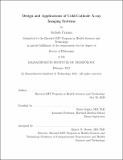Design and applications of cold-cathode X-ray imaging systems
Author(s)
Cramer, Avilash(Avilash Kalpathy)
Download1251801720-MIT.pdf (30.69Mb)
Other Contributors
Harvard--MIT Program in Health Sciences and Technology.
Advisor
Rajiv Gupta.
Terms of use
Metadata
Show full item recordAbstract
X-ray computed tomography (CT) and planar x-ray imaging are mainstays of modern clinical care. The electron generation mechanism in standard x-ray tubes - specifically, a thermionic cathode - is reliable and capable of high current. However, thermionic cathodes are bulky, and cannot be pulsed quickly. Non-thermionic ('cold-cathode') electron generation can be exploited to make a smaller and rapidly pulsable x-ray source. Such an x-ray source could improve not just the portability of x-ray devices, but would allow for a CT system to operate by pulsing a distributed ring of x-ray sources instead of rotating a single large x-ray source. Furthermore, cold-cathode x-ray sources could allow for new signal acquisition and processing paradigms in the x-ray domain. This includes time-based image acquisition techniques, such as elastography and photon-counting measurements. In this dissertation, I discuss (1) the development of two novel types of cold-cathode x-ray sources: an ultraviolet photocathode-based source, and a silicon field emission chip; (2) novel methods for planar x-ray image acquisition, including a demonstration of dynamic x-ray elastography using a pulsed photocathode x-ray source; and (3) applications of modern signal processing techniques to the tomographic image reconstruction problem. In an epilogue, I discuss our research on N95 respirator sterilization and re-use for crisis situations.
Description
Thesis: Ph. D., Harvard-MIT Program in Health Sciences and Technology, September, February, 2021 Cataloged from the official PDF version of thesis. Includes bibliographical references (pages 145-159).
Date issued
2021Department
Harvard University--MIT Division of Health Sciences and TechnologyPublisher
Massachusetts Institute of Technology
Keywords
Harvard--MIT Program in Health Sciences and Technology.